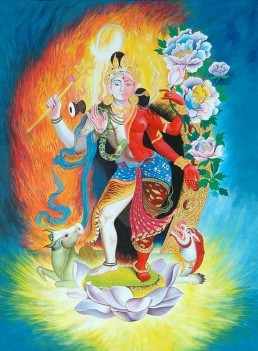Swami Chinmayananda
Swami Chinmayananda Commentary
One of the ways of defining the indefinable Supreme, the subject in the seeker himself, is to indicate It in a language of contradiction, which, without confusing the intellect, tickles it to a special kind of activity, thereby facilitating the realisation of the Eternal. The language of contradiction is the characteristic feature of all scriptural text-books. Hasty readers of the Scriptures quote these lines to justify their scepticism, or atheistic tendencies. This stanza is met with in the Upanishads also.
SEEMING TO POSSESS THE FUNCTIONS OF ALL SENSES YET DEVOID OF ALL SENSES — The Self in us, while functioning through the equipment, the sense organs, and conditioned by them, looks as though It has all the sense organs. But when we analyse, we have to admit that the sense organs are material and that they decay and perish, while the Consciousness — functioning in and through them and providing each of them with its own individual faculty, is Itself Eternal, and Changeless. The Truth, while functioning through the sense organs, looks AS THOUGH It possesses them. But in fact, It has Itself none of these faculties.
Electricity is not the light in the bulb, nor the heat in the heater; yet while functioning through the bulb, or the heater, and conditioned by them, the same Electricity looks AS THOUGH it is light or fire.
DETACHED, YET UPHOLDING ALL — This relationship of “detached support” is not too easy for the initiate to understand. But it is generally brought within our comprehension by the great teachers of our country through analogies. No wave is all the ocean; all the waves put together are also not the entire ocean. We cannot say the ocean is attached to the waves since the ocean is the very nature of the waves and, though detached, all the waves are always supported by none other than the ocean itself. Cotton is in all cloth; cloth is not cotton. And yet, it is the cotton in the cloth that “supports” the cloth.
Similarly, the world of plurality is not Consciousness. Yet Consciousness supports it. Between the ghost and the post, no attachment is ever possible and yet, the post alone is the “support” of the ghost — as the waking mind alone can support the “dreams.”
WITHOUT GUNAS, YET ENJOYING ALL GUNAS — The moods in which, and influences under which, human minds come to play and experience themselves are called “gunas.” These are influences that govern the mind and yet they are the objects of realisation or perception for the Conscious Self. A live mind alone can experience these influences. Consciousness conditioned by the mind is the Ego (Jiva), and is the experiencer (Bhoktri) of the guna. Unconditioned by the mind, in Its own nature, It is the Absolute.
Thus, in the stanza, the Self, as the Absolute, is described as beyond the sense organs, mind and intellect and detached from everything and without any relation to the various gunas.
But the same Self, conditioned by the sense organs, looks AS THOUGH possessing them all, and proves AS THOUGH It is the sustainer of them all, and expresses Itself AS THOUGH It is the experiencer of all the gunas.
NOT ONLY THIS, BUT THE SELF, FUNCTIONING IN AN INDIVIDUAL, IS THE ONE SELF IN ALL:
Adi Sankara Commentary
Sarvendriya-guna-abhasam, shining through the functions of all the organs: By the use of the words all the organs are understood ears etc., known as the sense-organs and motor-organs, as also the internal organs-the intellect and the mind, for they are equally the limiting adjuncts of the Knowable. Besides, the organs of hearing etc. become the limiting adjuncts from the very fact of the internal organ becoming so. Hence, the Knowable gets expressed through determination, thinking, hearing, speaking, etc. that are the functions of all the organs, internal and external, which are the limiting adjuncts. In this way, It is manifest through the functions of all the organs. The idea is that, that Knowable appears to be as though active owing to the functions of all the organs, as it is said in the Upanisadic text, ‘It thinks, as it were, and shakes, as it were’ (Br. 4.3.7). For that reason, again, is It not perceived as being actually active? In answer the Lord says: It is sarva-indriya-varitam, devoid of all the organs, i.e. bereft of all the instruments of action. Hence the Knowable is not active through the functioning of the instruments of action. As for the Upanisadic verse, ‘Without hands and feet He moves swiftly and grasps; without eyes He sees, without ears He hears’ (Sv. 3.19), etc.-that is meant for showing that that Knowable has the power of adapting Itself to the functions of all the organs which are Its limiting adjuncts; but it is not meant to show that It really has such activity as moving fast etc. The meaning of that verse is like that of the Vedic text, ‘The blind one discoverd a gem’ (Tai, Ar. 1.11). [This is an artha-veda (see note on p.530), which is not to be taken literally but interpreted in accordance with the context.] Since the Knowable is devoid of all the instruments of actions, therefore It is asaktam, unattached, devoid of all associations. Although It is of this kind, yet it is ca eva, also verily; the sarva-bhrt, supporter of all. Indeed, everything has existence as its basis, because the idea of ‘existence’ is present everywhere. Verily, even mirage etc. do not occur without some basis. Therefore, It is sarva-bhrt, the supporter of all-It upholds everything. There can be this other organs as well for the realization of the existence of the Knowable: Nirgunam, without quality-the qualities are sattva, rajas and tamas; that Knowable is free from them; and yet It is the guna-bhoktr, perceiver of qualities; i.e., that Knowable is the enjoyer and experiencer of the qualities, sattva, rajas and tamas, which, assuming the forms of sound etc., transform them-selves into happiness, sorrow, delusion, etc. Further,
The Bhagavad Gita with the commentary of Sri Sankaracharya – Translated by Alladi Mahadeva Sastry
Holy Geeta – Commentary by Swami Chinmayananda
The Bhagavad Gita by Eknath Easwaran – Best selling translation of the Bhagavad Gita
The Bhagavad Gita – Translation and Commentary by Swami Sivananda
Bhagavad Gita – Translation and Commentary by Bhaktivedanta Swami Prabupadha
Srimad Bhagavad Gita Chapter 13 – Verse 15 – 13.15 sarvendriyagunabhasam – All Bhagavad Gita (Geeta) Verses in Sanskrit, English, Transliteration, Word Meaning, Translation, Audio, Shankara Bhashya, Adi Sankaracharya Commentary and Links to Videos by Swami Chinmayananda and others – 13-15

